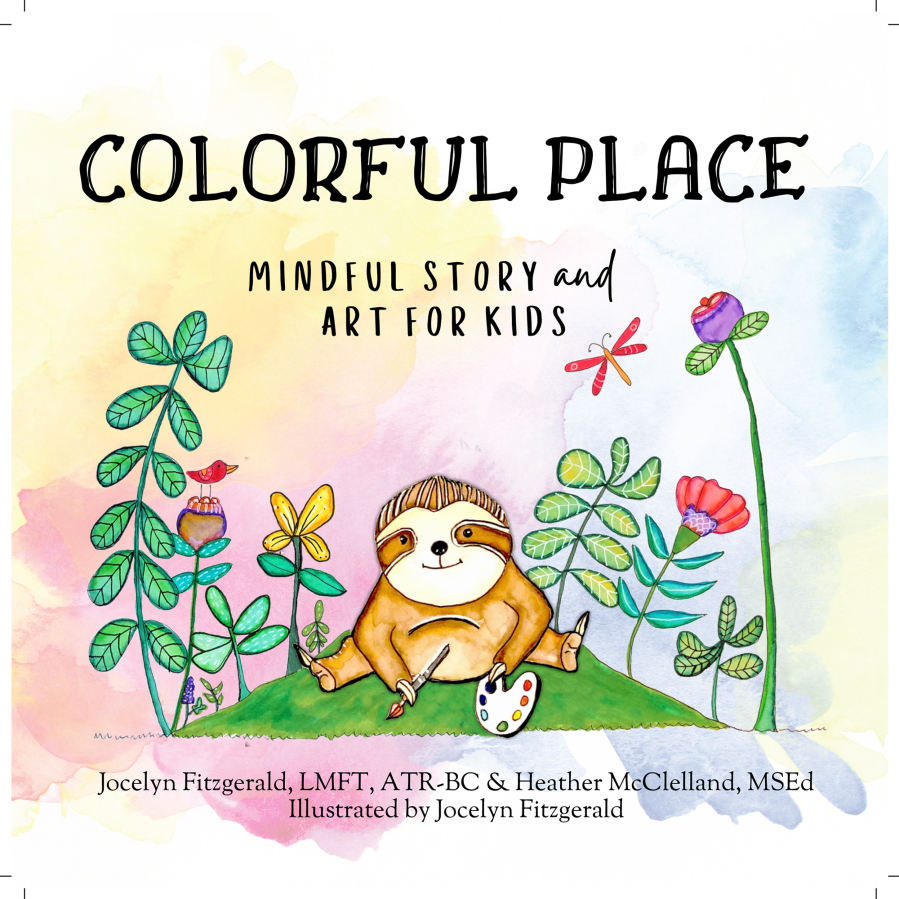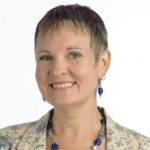What if you could feel less anxious right now simply by drawing a rainbow?
It’s not as silly as it sounds. Although we might dismiss doodling with colors as child’s play, a great deal of research and an entire field of therapeutic practice confirms that the process of artmaking is an effective (and really fun) way to worry less.
Jocelyn Fitzgerald and Heather McClelland had children in mind when they co-authored “Colorful Place: Mindful Story and Art for Kids,” a workbook offering art exercises for parents and children to do together. The book, which features Fitzgerald’s vibrant, free-flowing watercolor-and-ink illustrations, espouses mindfulness principles that can benefit anyone, no matter what age.
“Parents say, ‘You just need to calm down,’ and the kids are like, ‘But how do I calm down?’ ” said Fitzgerald, a licensed marriage and family therapist and board-certified art therapist who owns her own practice on Vancouver’s Officers Row. “This book is just as much for parents as it is for kids. We have these ‘mirror neurons.’ Kids are feeding off their parents’ energy, and if you don’t know how to calm yourself down, how can you expect your kids to?”
Fitzgerald uses art and creativity for clients of all ages, not only to alleviate anxiety and relieve stress but also to resolve conflict, increase self-esteem and self-awareness and manage overwhelming emotions.
About five years ago, she met McClelland, a behavior intervention teacher for the Vancouver School District with a master’s degree in education who uses mindfulness techniques to help kids. They both had sons in kindergarten. Fitzgerald and McClelland sat together at school basketball games and chatted about their work. (“We have this professional crush on each other,” joked McClelland.) Both were inspired by the similarities between mindfulness and artmaking.
Focus on senses
The goal of mindfulness, McClelland said, is to anchor yourself in the present moment, resisting the inclination to project yourself into an uncertain future, or ruminate on past hurts and mistakes. Artmaking achieves the same outcome by focusing attention on what’s immediately in front of you: What’s the next color, the next line, the next brushstroke? It anchors you to the present by making you aware of your senses – what you’re seeing and how the brush feels as it moves across the page. It also connects you to your inner self by engaging your imagination.
Fitzgerald and McClelland discussed working collaboratively but never found the right project until a few months into the pandemic. Fitzgerald was conducting remote sessions for an increasing number of anxious young patients, and McClelland (who had moved all her social-emotional learning groups online) noticed that many kids who really needed support weren’t logging on, while others seemed starved for interaction. Both women were concerned about how children would fare, not just during the pandemic but also after.
“You realize the need is so great to learn skills to get through not just this hard time we’re in, but later,” McClelland said. “When we come back together in person, we’re going to have to work so much harder to repair the trauma that has happened.”
McClelland was careful to distinguish between “trauma with a capital T and trauma with a lowercase t.” Clinical trauma includes toxic stress, insecure housing and food supply, or substance abuse in the home. She said that even for kids from stable families who have their basic needs met, the pandemic is still a traumatic experience.
“What we tried to create in the book was something that appeals to and can help both of those groups. Whether it’s families that pick up our book, or a school social worker that is working with capital T childhood trauma, the book works for both,” McClelland said. “It’s rooted in as much brain research as possible so that it could work for as many people as possible.”
Helping parents, kids
The beauty of the book is that it provides a “twofer,” said Jennifer McMillan, a therapist with a private practice who also serves as the Camas School District’s social-emotional wellness liaison.
“Kids will be learning something, but parents will be learning something right alongside them,” said McMillan, who sees many young patients with acute anxiety.
It’s hard to help children deal with their anxiety in isolation from their parents, she said. Everyone falls somewhere along an anxiety spectrum, leaning toward anxiety or leaning away.
“Our nervous systems read each other. We can sprinkle our anxiety onto each other inadvertently,” McMillan said.
She was quick to point out that this isn’t a criticism of anxious parents, but something to be aware of during the pandemic, which has pushed even nonworriers into daily anxiety. Whatever the parents’ state of mind, it trickles down to children, who are hyper-attuned to their parents’ moods.
“What worry likes to do is, it really likes to engage in the feeling part of the brain,” McMillan said. “Feelings are just visitors. They come and go. They’re not facts. They’re fluid. Anxiety likes to endorse thinking errors and rigid thinking, like ‘I’m always going to feel this way. I’m never going to get better.’ But we know that’s not true. Life is more in the gray.”
McMillan said it’s important to remember that anti-worry strategies can’t be built when you’re flooded with big emotions. Learning how to manage anxiety is best done when you’re not anxious.
“The time to fix the roof is when the sun is shining. The time to work on these skills of learning how to calm your nervous system is when you’re settled. That’s what books like Heather and Jocelyn’s does; it allows for practice,” McMillan said.
‘Art recipes’
The book begins with a “mindful story,” a series of prompts to connect readers with their senses, notice their feelings without judgement and imagine the “colorful place” of the book’s title. Relaxation is encouraged through measured breathing, stretching and gentle movement.
The story sets the stage for “art recipes.” The book includes instructions for making liquid sidewalk chalk, a guide for creating abstract art out of coffee filters or making a coffee-filter rainbow with cotton ball clouds, suggestions for an “imagination collage” and a how-to for making “drag, scrape and push art.” After each art project, questions encourage discussion about feelings and sensations experienced during artmaking.
“The art is meant to be about process and not product,” Fitzgerald said. “It doesn’t matter what they create. It’s about spending time in the process of creativity.”
McClelland and Fitzgerald emphasized that regular practice is what matters, not following directions. It’s about using creativity as a daily tool to find serenity and even joy in the present moment. It’s transformative because it solidifies an understanding that a calmer perspective is always accessible, that everyone has “the power to regulate their emotions with their imaginations,” as Fitzgerald put it.
“Your brain is the most amazing, imaginative tool you could use,” Fitzgerald said. “I see it all the time with adults; they forget that they have this unique creative spirit in them. Everyone has that ability.”
Both Fitzgerald and McClelland hope that parents and children will visit their “Colorful Place” long after the pandemic is over because life can be stressful even under normal circumstances.
“It’s not a magical cure,” Fitzgerald said. “It’s not as good as therapy but it’s something we could do tangibly, something we could create together that could help kids.”
The book is available for $16 from www.breatheartcalm.com.




